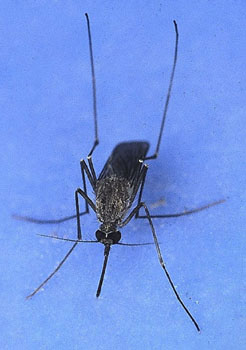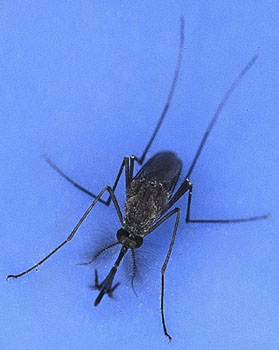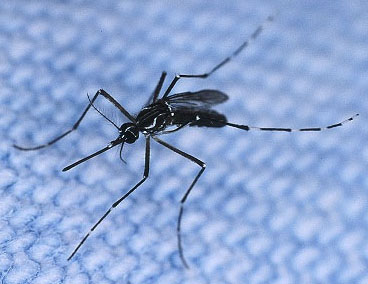As I walked into the “hammock” (what Floridians call a hardwood forest,) near Lake Kanapaha, southwest of Gainesville, I was almost immediately aware of being followed. Large black mosquitoes with white tarsi flew in clusters just behind me. They were aptly named Psorophora ferox (“ferox” means ferocious). Their bites were fairly painful, but not so much as those of their larger relative, Psorophora ciliata, which is the largest blood-feeding mosquito in the United States. I had once been attacked by this “Jersey” skeeter and knew how its bite could hurt.
|
|
Along the lake shore that evening I was again attacked, but this time by whole airforces of an even more numerous biter, Coquillettidia perturbans. This mosquito made it pretty much impossible to be at the edge of the shallow lake without liberal applications of DEET. In fact life in shady woods during the day or just about anywhere after dark in Florida was fraught with the danger of attack by one or the other of these tiny vampires. Even winter did not totally end the attacks, especially in south Florida. I was once attacked by mosquitoes at Royal Palm Hammock in Collier-Seminole State Park in December. However, summer is the prime time for mosquitoes, and Florida is gifted with nearly all of the mosquito genera known from the United States. Aedes aegypti, the yellow fever mosquito, could easily be found by looking in any old exposed washing machine, where they would lay their eggs. The elegant Uranotaenia sapphirina was often spotted on palm fronds above creeks and marshes where it feeds on the blood of frogs and reptiles. Anopheles crucians was often found in numbers under wooden walkways in swamps even in winter. The house mosquito, Culex quinquefasciatus, made lives miserable on the Gulf of Mexico islands. South Florida contained numerous Ochlerotatus sollicitans and O. taeniorynchus (salt marsh mosquitoes), as well as Deinocerites cancer (the crab-hole mosquito), and species of Mansonia and Wyeomyia. Occasionally one would find the elegantly pinstriped Orthopodomyia signifera in Gainesville. Treeholes abounded in the larvae of Ochlerotatus triseriatus and the predatory Toxorhynchites rutilis.
|
Female Culex quinquefasciatus mosquito. |
Male Culex quinquefasciatus mosquito. |
The last named species is especially interesting as neither of the sexes feed on blood! In most mosquito species only the female engages in blood sucking. She needs a blood meal to produce her eggs. Males are nectar-feeders. However both the male and the female of Toxorhynchites are nectar-feeders. Thus the adults are rarely seen. The males, like most male mosquitoes (Deinocerites is an exception), have very bushy antennae that are well supplied with auditory receptors to detect the characteristic female whine. In addition, both male and female Toxorhynchites have an unusual (for mosquitoes) curved proboscis. Both are also metallic purple, green and blue, with white markings. These characteristics, plus the mosquito's large size (it is as large as the blood-sucking Psorophora ciliata) made it easy to identify the mosquito in the movie “Jurassic Park”, supposedly used to extract dinosaur blood, as a male Toxorhynchites! I used to raise the easier to find larvae of T. rutilis to adulthood in foam coffee cups covered with rubber band-secured bridal veil. I fed them larvae of O. triseriatus that I dippered out of tree holes in back of Bartram Hall at the University of Florida. A half-dozen O. triseriatus larvae would disappear overnight, leaving a somewhat fatter Toxorhynchites larva!
|
Aedes aegypti (Yellow Fever mosquito) female |
Aedes aegypti (Yellow Fever mosquito) female |
Mosquitoes are notorious for their disease-carrying abilities. The list of mosquito-borne diseases includes such horrors as four varieties of malaria, yellow fever, dengue, several forms of equine encephalitis, West Nile virus, various filarial worms and several tropical arboviruses that have not yet entered Europe or North America. West Nile virus, which had already invaded Europe, is now sweeping westward from its introduction point in New York. It has reached the Mesilla Valley of the Rio Grande where I now live. This summer several horses are dead from the virus and the disease is making itself known in the human population. Meanwhile in Florida an “older” and even more dangerous native North American disease, eastern equine encephalitis, is killing horses and has infected several people.
Dengue is also a possible problem in the U.S., having moved close to our southern border and with very good vectors in the Asian tiger mosquito (Aedes albopictus) and the yellow fever mosquito (Aedes aegypti). While the Asian tiger mosquito was expected in New Mexico at any time (it had pretty much overrun the Southeast United States and much of Texas), it was the old-fashioned yellow fever mosquito that made its appearance in 2002. Now there is a thriving population of this pretty white and black mosquito in the Mesilla Valley (including my yard!) It had been eradicated from the western United States in the last century, only to return. We still await the Asian tiger mosquito and also the possibility of dengue, also known as break bone fever in one of its more unpleasant forms. Fortunately, yellow fever is currently far to the south, but we cannot forget that this “tropical” disease once ravaged Philadelphia in the 18th Century, leaving hundreds dead.
Malaria also has made recent inroads. Relatively recent cases in New York City, Florida and California are demonstrating that our old scourge is retaking its old distribution. The eradication of malaria envisioned by WHO did not succeed, although now there is hope of a vaccine. The problems of developing such a vaccine are multitudinous, as the malarial parasite is a moving target, now in the blood stream, now in the liver, now in the salivary glands of an Anopheles mosquito. Malaria is primarily a disease of humans, other primates, birds and lizards. Unlike the viruses, malarial parasites are visible with a light microscope, although they are best viewed at 1000X under oil immersion objectives after being mounted in a blood smear. As a parasitology student at the University of Arizona I looked over many such slides that my instructor had brought back from Africa, where all four species of malarial parasites (Plasmodium vivax, P. falciparum. P. malariae and P. ovale) that attack humans are found.
Despite the fact that mosquitoes are responsible for killing more people than just about any other organism (malaria alone kills over 2 million people annually), many are quite fascinating in their own right. The crab hole mosquito for example breeds in (as the name implies) crab holes in brackish water along the cost of Florida. The males wait for emerging females on the surface of the water and thus do not need the bushy antennae to sense the female. Mosquitoes in the genus Wyeomyia may lay their eggs in pitcher plants or epiphytic bromeliads. Mansonia and Coquillettidia mosquito larvae pierce water plants to get at air bubbles while most other mosquito larvae breath atmospheric oxygen by holding their siphons up to the surface film of their pool. The larvae, or wigglers, are amazing creatures. Most have mouth brushes through which they filter small organisms, while some (at least a few Psorophora and of course Toxorhynchites) are predatory on other mosquito larvae. The pupae are also very active but the breathing apparatus is quite differently located on the thorax. These “thoracic horns” connect to the thoracic spiracles. Mosquito larvae are easily raised in foam coffee cups, as noted for Toxorhynchites, and most thrive on a diet of fine tropical fish food (only a pinch per day) dropped in their cup. Except for the predatory species, they can be raised together in the cup if not over crowded.
In New Mexico the most abundant mosquitoes are species of Psorophora, Culex, Aedes and Ochlerotatus. In pecan orchards life in summer is made miserable by Aedes vexans, while open areas where water collects may produce daunting hoards of Psorophora columbieae. I have had a few of my worst experiences with mosquitoes in New Mexico at a creek near Raton and along Interstate 10 near Road Forks. The latter is caused by the presence of huge playa lakes along the freeway. These lakes are filled with water after heavy summer rains and their large surface area, shallowness and lack of predatory fish provides a perfect habitat for mosquitoes.
The name mosquito means “little fly” in Spanish, while in England these same beasts were called “gnats.” This is almost certainly the gnat that Alice talked to in Wonderland. Why mosquito stuck in American English and gnat did not is a very good question, akin to why el lagerta became Alligator- probably just frequency of usage in a country (United States) where Spanish was often mixed with English. Mosquitoes were certainly noticed since earliest times, but it was only with such researchers as Sir Patrick Manson, Sir Ronald Ross, Giovanni Battista Grassi, Carlos Finlay and Walter Reed that the mosquito-disease connection was proven. The very name “malaria” came from the mistaken notion that the disease was caught from a miasma emanating from swamps. They were right in one aspect; malaria is often associated with bodies of water because that is where mosquitoes breed.
Mosquitoes, both adults and larvae, can only be identified for certain under a binocular dissecting microscope. Under such a microscope mosquito adults can become objects of beauty. Some like Sabethes, Haemagogus, Uranotaenia and Toxorhynchites, exhibit brilliant metallic scales, while others are elegantly covered with scales of various shades, including white. Their head and proboscis, as well as their scale-spangled wings are quite impressive at high magnifications (40X or higher)
Mosquitoes are certainly formidable foes to mankind. Probably billions of humans have died from the diseases these tiny insects transmit. However, they are also fascinating subjects for investigation. The study of these creatures is not just a curiosity, but accurate biological data may have unquestionable medical value. Try raising a few wigglers and examining them under a dissecting microscope. You will find that yet another frontier is opening up before your eyes!
For references try J. D. Gillett, 1972. The Mosquito, Doubleday, Garden City, NY, which is still a great read, and the more recent work by A. Spielman and M. D'Antonio, 2001. Mosquito, Hyparion, New York.
Comments to the author, David Richman, are welcomed.
All photos by and © David B. Richman.
Microscopy UK Front Page
Micscape
Magazine
Article
Library
© Microscopy UK or their contributors.
Published in September 2003 Micscape Magazine.Please report any Web problems or offer general comments to the Micscape Editor.
Micscape is the on-line monthly magazine of the Microscopy UK web site at Microscopy-UK
© Onview.net Ltd, Microscopy-UK, and all contributors 1995 onwards. All rights reserved. Main site is at www.microscopy-uk.org.uk with full mirror at www.microscopy-uk.net .




